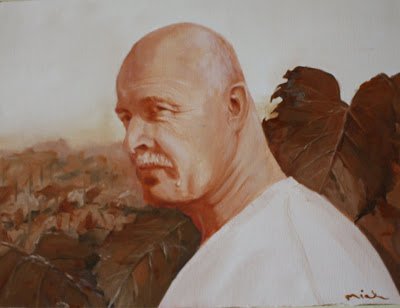MICHELLE TEITSMA
Artist Statement
My paintings are the culmination of an ongoing study of Greenbelt legislation imposed on farmers, including grape and tender fruit growers. Going into this project I had intended to depict the many benefits of the Greenbelt legislation. However, after interviewing people who are closely affected by this law I have discovered that there is more to the Greenbelt act than I had anticipated.
Orest and the ruined grapes
oil on canvas
16x20in, 200
Since all of the canneries have closed or moved, the mainstay of income from farming has drastically shifted and many have been forced to sell. Growers who tried to keep farming their land- who have been doing so for generations- cannot exist solely on selling to farmers' markets. The major markets buy imported foods that are less expensive because of cheap labour overseas and warmer climates that allow for three or four harvests. That is why we can purchase food from China so easily as opposed to finding Ontario produce in our local grocery stores.
However many of the countries that we import our foods from, like Argentina, do not have strict regulations for pesticides. We do, and rightly so, but this is at the expense of the farmer. In years past when there was an industry for Ontario farmers to sell in this country, when the canneries were in business, the farmers had to deal with the usual problems such as weather, disease and pests. But they had options in order to get them through.
One of the most devastating impacts of the Greenbelt law is that a farmer is no longer able to sever land.' Pre'- Greenbelt, if a grower had any agricultural problems that would set them back a year or more, they had the option of severing some of their land to sell in order to offset this loss. They would still be able to function as a farm and 'weather the storm'. Under Greenbelt restrictions they cannot do this.
There is also the issue of trying to sell their farms- to forfeit all that they have worked for and all that they intended to pass onto their children. Land ‘protected’ under Greenbelt legislation is more challenging to sell as it puts constraints on what it’s owner can and can not do with it.
In the end, will we end up with abandoned farms and land that is fallow? There are a lot of positive sides to the Greenbelt Legislation but what is the cost to our agricultural sector? To our small family farms? To us? Do we want to eat more imported foods? Growing food locally could be more challenging in these uncertain times, especially with weather patterns changing or if countries stop importing our food supply- will we have options?
My works featured in this exhibition are portraits of the people. They are our farmers. Our grape and tender fruit growers. These are faces of families who have worked so very hard to do what they love and to make a living. I hope my paintings convey pride in these stewards of our land and I am thankful to those who have laboured to sustain it.
oil on canvas
Paintings for this exhibition will consist of approximately ten to twenty portraits rendered in oil on canvas sizes ranging from 16x20in to 30x40in. My intention is to portray the intimacy between the viewer and the subject of the portrait, inviting one to respond to the faces of the men and women who work our land.


No comments:
Post a Comment